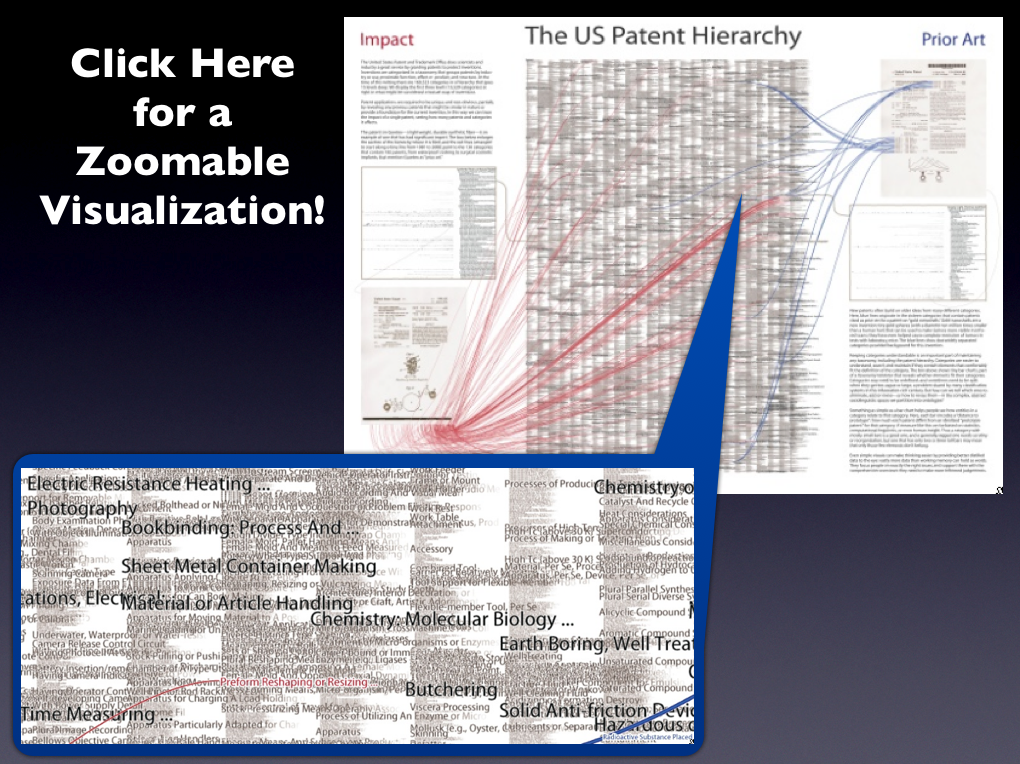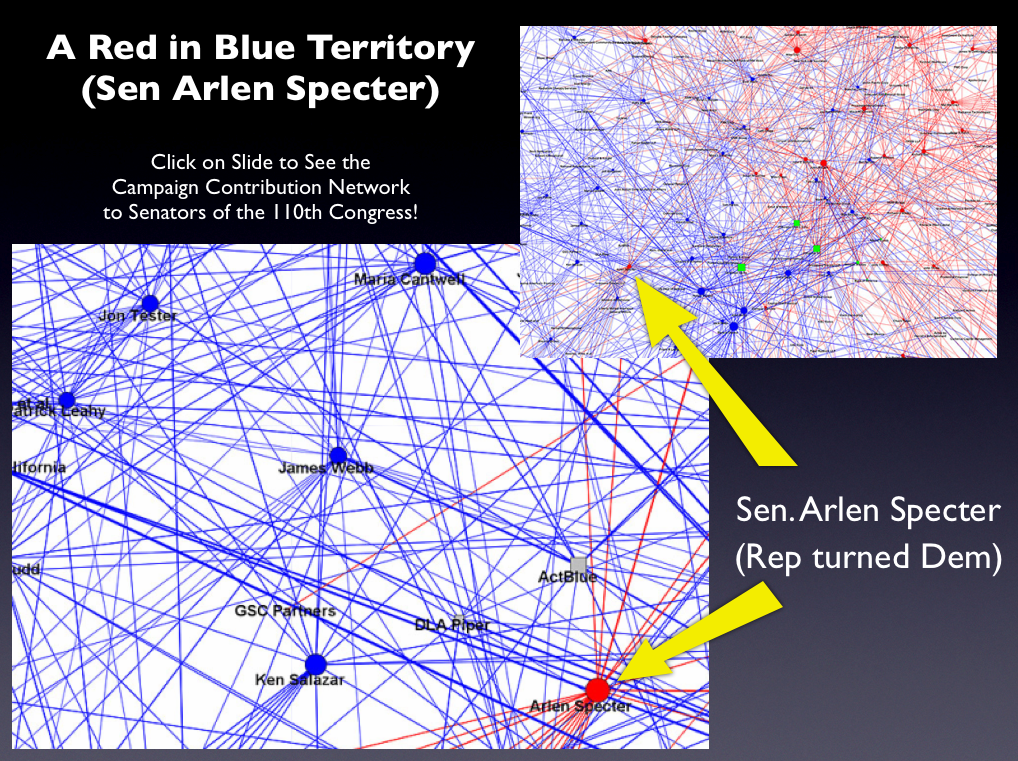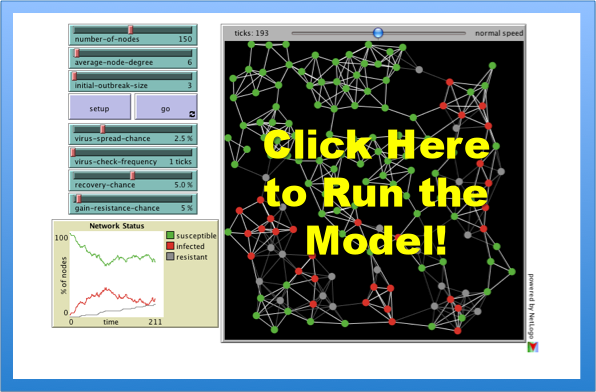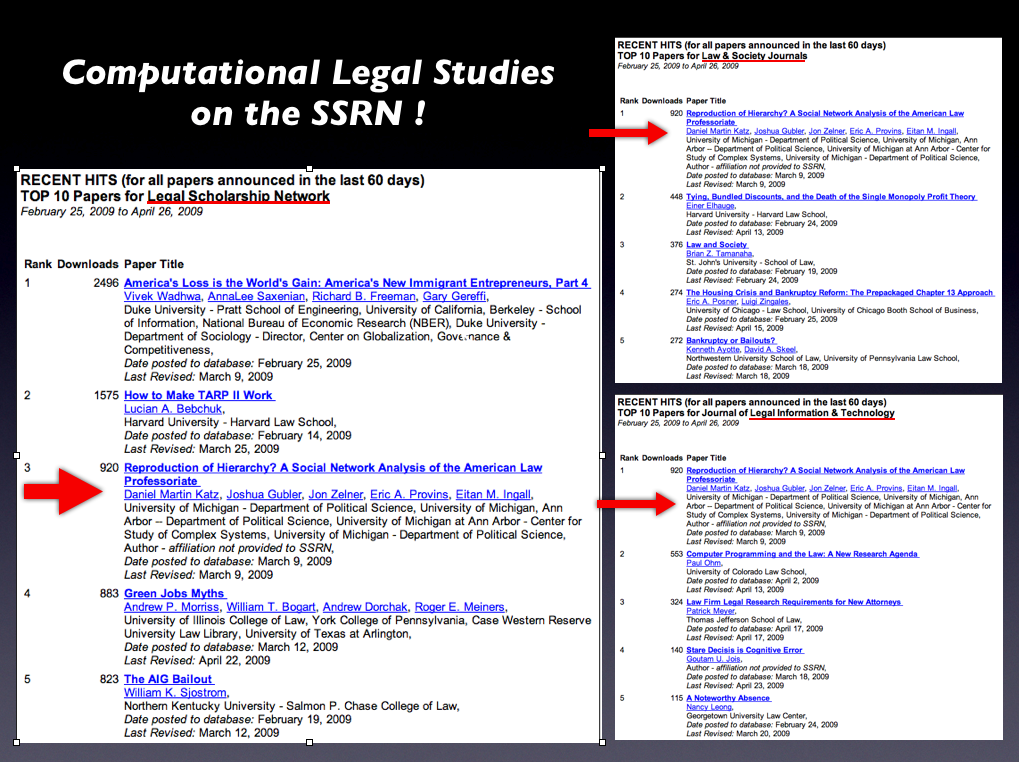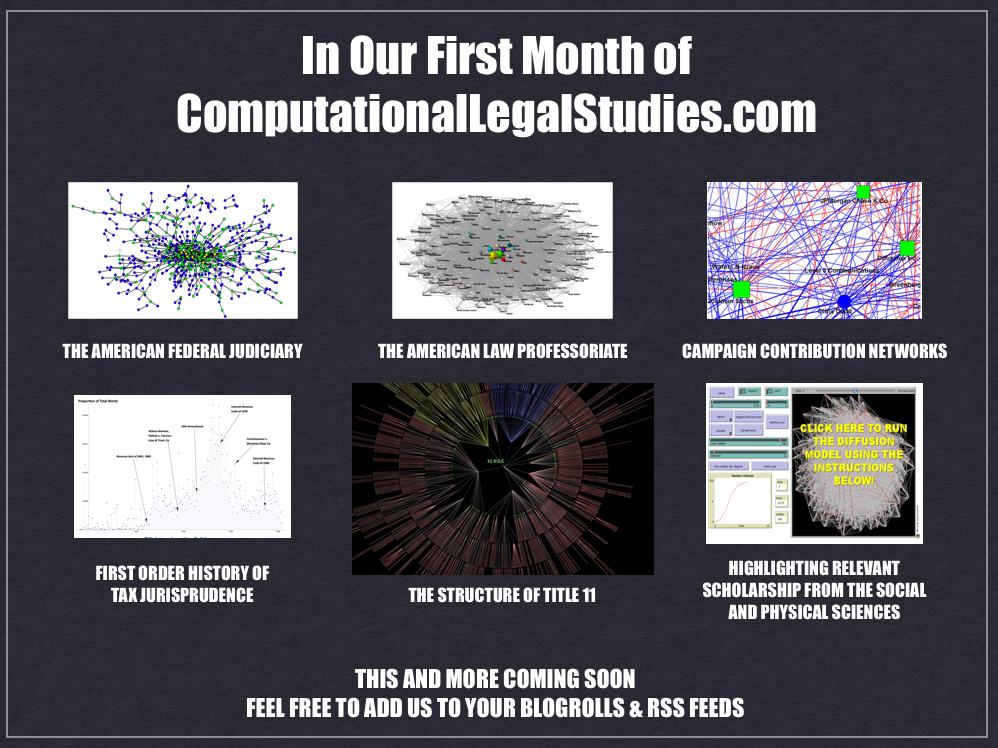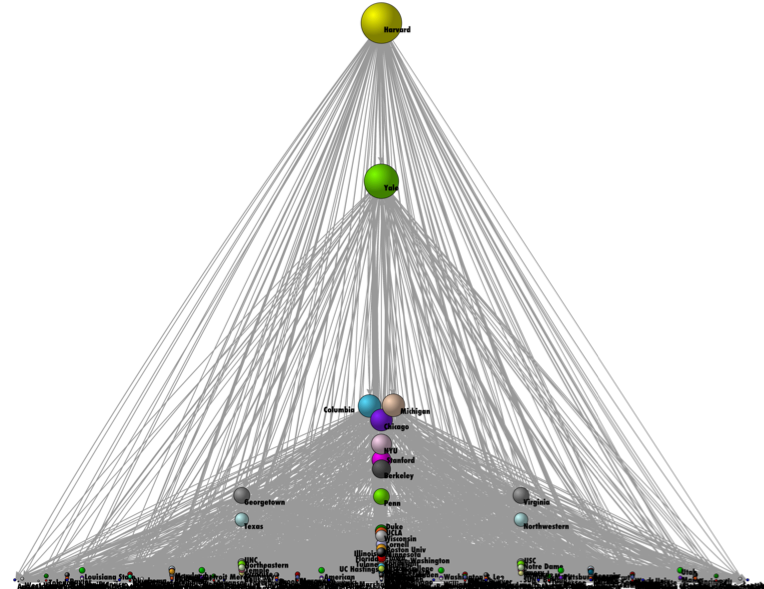Datavisualization.ch/ recently highlighted this interactive “Bailout Breakdown” offered by the Associated Press….. “Bailout Breakdown from Associated Press is an interactive applet that lets the user analyze the recipients and amounts of the $700 Billion bailout plan from the American government. The data is presented as a scatterplot with additional information about the representations when the hovers over a plotted item. The markers are color coded to distinguish between pending, pre-approved, approved and paid status.” At the end of his post, Benjamin Wiederkehr offers some principled critiques of the visualization techniques employed by the authors. Notwithstanding, we still thought it was still worthy of highlighting.
–
Classifying the US Patent Hierarchy
The United States Patent and Trademark Office patent classification scheme organizes 3 million patents into about 160,000 distinct patent classes. This visualization by Katy Börner, Elisha Hardy, Bruce W. Herr II, Todd M. Holloway, & W. Bradford Paley considers the organizational schema used to classify patents at the US Patent Office. Their article Taxonomy Visualization in Support of the Semi-Automatic Validation and Optimization of Organizational Schemas was published in the Journal of Informetrics in 2007.
From the Abstract: “The taxonomy visualization and validation (TV) tool introduced in this paper supports the semi-automatic validation and optimization of organizational schemas such as file directories, classification hierarchies, taxonomies, or other structures imposed on a data set for organization, access, and naming. By showing the “goodness of fit” for a schema and the potentially millions of entities it organizes, the TV tool eases the identification and reclassification of misclassified information entities, the identification of classes that grow too large, the evaluation of the size and homogeneity of existing classes, the examination of the “well-formedness” of an organizational schema, and more.”
The Real Estate Roller Coaster — Visualizing the Speculative Bubble
We are working hard to produce more original content for the site. In the meantime, we want to share some of our favorite projects and papers. Many of you have probably seen this visualization of housing prices–including the run up to 2007. For those of you not previously familiar, the authors plotted inflation adjusted US Home Prices (1890-2006) on a roller coaster! Pretty creative stuff….
Perils of Interdisciplinary Scholarship — Evading the Discipline Police?

It is difficult to traverse the broad disciplinary landscape. We feel so fortunate to work with a community here at Michigan which is committed to resisting those who seek to restrict intellectual innovation–individuals we characterize as the disciplinary police. Since starting this blog, we have received several emails from legal, social and physical science scholars interested in intellectual exploration, intellectual diversity. We appreciate their encouragement and will proudly continue to privilege “exploration over exploitation.”
In that vein, we wanted to offer some of our favorite recent papers drawn from a wide variety disciplines….
FIVE PAPERS FROM VARIOUS DISCIPLINES WE WANT TO HIGHLIGHT:
Gergely Palla, Albert-László Barabási & Tamás Vicsek, Quantifying Social Group Evolution, Nature 446: 664-667 (5 April 2007)
John Mikhail, Universal Moral Grammar: Theory, Evidence, and the Future, 11 Trends in Cognitive Sciences 143 (2007)
Jenna Bednar & Scott Page, Can Game(s) Theory Explain Culture? (The Emergence of Cultural Behavior Within Multiple Games), Rationality and Society, 19: 65-97 (2007).
Riley Crane & Didier Sornette (2008) Robust Dynamic Classes Revealed by Measuring the Response Function of a Social System, Proc. Nat. Acad. Sci. 105: 15649-15653.
Frans de Waal, Kristen Leimgruber & Amanda Greenberg (2008). Giving is Self-Rewarding for Monkeys. Proc. Nat. Acad. Sci. 105: 13685-13689.
Judge Sonia Sotomayor ⇒ Justice Sotomayor?
Justice Souter’s recently announced retirement has generated significant speculation regarding the potential nominee President Obama might select.
Barring some unknown skeleton in her closet, if President Obama seeks to (1) select a Federal Court of Appeals Judge and (2) increase the diversity of the Court on multiple dimensions …. well … Judge Sotomayor would have to be the frontrunner.
The picture and graph statistics pictured above are drawn from our paper Hustle and Flow: A Social Network Analysis of the American Federal Judiciary. In the paper, we offer a mapping of the social topology of the American Federal Judiciary. Built upon data aggregated over the Natural Rehnquist Court (1995-2004), we find Judge Sotomayor holds a position of significant social prominence.
To read more on operationalization, etc.—click on the slide above or click here.
A number of commentators have suggested President Obama might forgo nominating a sitting judge — instead choosing an academic or politician. This is certainly a possibility and in that vein let me reveal my bias in favor of Gov. Jennifer Granholm (for whom I formerly worked).
Jones & Brosnan: Local Interaction, Strategy Dynamics and the Emergence of Reciprocity in Chimpanzee Social Networks
Following up from the very interesting recent Society for Evolutionary Analysis in Law Conference (SEAL 10) at Vanderbilt Law School, I wanted to briefly highlight some compelling scholarship offered Greg Jones & Sarah Brosnan. In their paper, Social Contracts on Social Networks: Local Patterns of Interaction, Local Strategy Dynamics and the Emergence of Reciprocity they explore cooperative, prosocial behavior in chimpanzees. The paper is both empirical and computational in nature.
I recognize that primatology represents a novel domain for many social scientists and legal scholars. In the March (1991) framework, we here at the CLS Blog believe exploration of a wide number of intellectual domains should be privileged over the mere exploitation of current approaches. For those interesting in such exploration, please consider downloading and reading this article.
Justice Souter to Retire….Possible Replacements?…Here is a Mapping of Socially Prominent Jurists in the American Federal Judiciary
NPR’s Nina Totenberg is reporting that Justice Souter is planning to retire at the end of the current Supreme Court Term. As noted in the NPR report, the short list of replacements may include Elena Kagan, Diane Wood and/or Sonia Sotomayor (who is in the network above near Justice Stevens). If President Obama decides to look beyond this early short list, he might consider one of the socially prominent federal jurist mapped in above visualization. We have a much more detailed prior post on the underlying paper Hustle and Flow: A Social Network Analysis of the American Federal Judiciary located here. To see the full visualization contained within the paper, click on the slide above or click here.
Taking Judicial Content Seriously–Lupu & Fowler’s Strategic Content Model
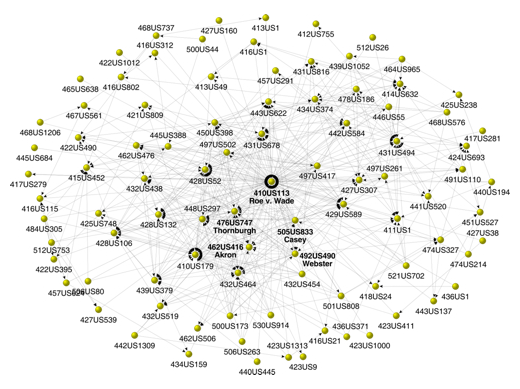
In my conversations with judicial politics scholars, many lament how many of our existing approaches tend to ignore opinion content. For those interested in embedding opinion content into existing theories of judicial decision making … consider Yonatan Lupu & James Fowler’s paper recently posted to the SSRN.
The authors present a strategic model of judicial bargaining over opinion content. They note … “we find that the Court generates opinions that are better grounded in law when more justices write concurring opinions.” To generate the specification for “grounding in law” the authors use Kleinberg’s Hubs and Authorities Algorithm calculated at the time the opinion was authored. The Strategic Content Paper is available here.
The visual above is drawn from a related Fowler project located here. Another very worthwhile paper authored by Fowler, Johnson, Spriggs, Jeon & Wahlbeck is located here.
The S.I.R. Model — A Simple Model With Applications to Swine Flu, etc.
Last week we offered a model of intellectual diffusion built upon a standard fare social epidemiology model. Given recent events within the United States, Mexico and potentially worldwide, we thought it would be worthwhile to highlight the classic S.I.R. (Susceptible, Infected, Recovered) model. Netlogo offers a user friendly version of the model. Using this platform, we hope the exploration of the dynamics of S.I.R. might prove illuminating.
First, various hosts have different levels of interactions (work, home, transit, etc.) and so this network approach represents a blunt measure. To start the model at the default parameters, push the SETUP Button and then the GO Button. As the model runs, the plot tracks the Susceptible, Infected, Recovered. The model contains a variety of “sliders.” The model can be rerun at lots of combinations of parameter levels. Those “sliders” fall into several categories: Network Attributes, Virus Attributes, Node Attributes. The full documentation is available here.
With respect to the swine flu, one important parameter is the delay between when an individual becomes infectious and when that individual is likely to become symptomatic. This parameter can be tuned in the simulation above using VIRUS-CHECK-FREQUENCY slider. From the documentation… “Infected nodes are not immediately aware that they are infected. Only every so often (determined by the VIRUS-CHECK-FREQUENCY slider) do the nodes check whether they are infected by a virus.”
An additional parameter worthy of consideration is the VIRUS-SPREAD-CHANCE. Consider this slider as a rough measure of the underlying infectiousness of the virus in question.
It is important to note the above simulation is an incredible simplification of the world faced by public health officials. Additionally, this version of the model was designed to consider the spread of disease on a computer network. Notwithstanding these limitations, we thought it useful to highlight a computational approach to this important matter of public concern.
The CLS Working Group on the SSRN!
Having finished a week discussing our paper Reproduction of Hierarchy? A Social Network Analysis of the American Law Professoriate, I wanted to take a moment to congratulate my colleagues on the SSRN download success of the paper! I hope lots of folks read the paper and it spurs a computational and complexity revolution in legal science.
The Revolution Will Not Be Televised — But Will it Come from HLS or YLS ? A Social Network Analysis of the Legal Academy (Part IV)

This is the final installment of posts related to Reproduction of Hierarchy? A Social Network Analysis of the American Law Professoriate. Thanks for your emails.
Here is the plot we provide within the paper. As a general proposition, we believe this represents an upper bound measure for the intellectual reach of an agenda offered by a given institution. With respect to our version of the Reed Frost Epidemiological Model, we use the p parameter to model “idea infectiousness.” When p = 1 every institution “contacted” by the idea is infected with the idea. When p = 0 no institution “contacted” by the idea is infected. In this version, we use the programming language python to run the model 500 times per institution. The above plot represents an estimate of the “diffusion curve” for each of the 184 institutions in our model. Building off central limit type properties, this leaves a far better estimate of reach than is offered in the single model run from the previous Netlogo GUI.
A cursory review of the above plot demonstrates, we are far from the land of linearity. Namely, a large number of institutions are able to reach much of the graph with very small changes in the value of p.
In the Structure of Scientific Revolutions, Kuhn quotes from Max Planck: “a new scientific truth does not triumph by convincing its opponents and making them see the light, but rather because its opponents eventually die, and a new generation grows up that is familiar with it.” Following Planck, we believe retirement is indeed be an important mechanism. However, we also argue the nature of the p parameter is a relevant consideration. In fact, unpacking various dimensions of p is the key to the broader model. Specifically, what are the properties of an idea that generate its infectiousness? Of course, we might like to believe infectiousness is related to a class of normatively attractive properties such as promoting efficiency or justice. However, it is not clear that this follows.
We took no pass on the question of whether some institutions would be better or worse at producing ideas with greater or lesser values of p. The motivated question for this post considers whether, in general, the institutions which are top producers of law professors are (1) leaders in innovation, (2) subsequent ratifiers of a newly established paradigm or (3) defenders of the status quo. In a deep sense, we are asking how to reasonably model decision making by the heterogeneous agents located at such institutions. Do institutions reward or punish intellectual risk-taking, search, etc.?
While this is an empirical question beyond the scope of this post, it worth asking because it partially informs the micro-dynamics plausibly responsible for generating the spread of new intellectual paradigms.
Model of Intellectual Diffusion Upon the American Legal Academy
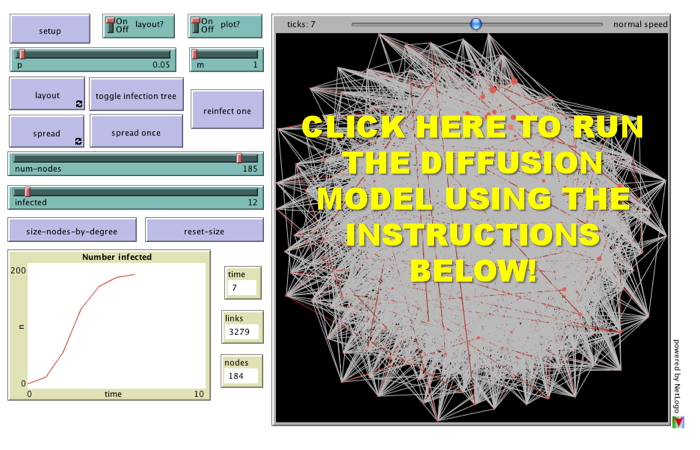 For the third installment of posts related to Reproduction of Hierarchy? A Social Network Analysis of the American Law Professoriate, we offer a Netlogo simulation of intellectual diffusion on the network we previously visualized. As noted in prior posts, we are interested legal socialization and its role in considering the spread of particular intellectual or doctrinal paradigms. This model captures a discrete run of the social epidemiological model we offer in the paper. As we noted within the paper, this represents a first cut on the question—where we favor parsimony over complexity. In the paper and in the model documentation, we offer some possible model extensions which could be considered in future scholarship.
For the third installment of posts related to Reproduction of Hierarchy? A Social Network Analysis of the American Law Professoriate, we offer a Netlogo simulation of intellectual diffusion on the network we previously visualized. As noted in prior posts, we are interested legal socialization and its role in considering the spread of particular intellectual or doctrinal paradigms. This model captures a discrete run of the social epidemiological model we offer in the paper. As we noted within the paper, this represents a first cut on the question—where we favor parsimony over complexity. In the paper and in the model documentation, we offer some possible model extensions which could be considered in future scholarship.
Once you click through to the model, here is how it works:
(1) Click the Setup Button in the Upper Left Corner. This will Display the Network in the Circular Layout.
(2) Click the Layout Button. Depending upon the speed of your machine this may take up to 30 seconds. Stop the Layout Button by Re-Clicking the Button.
(3) Click the Size Nodes by Degree Button. You Will Notice the Fairly Central Node Colored in Red. This is School #12 Northwestern University Law School. Observe how we have set the default infected school as #12 Northwestern (Hat Tip to Uri Wilensky). A Full List of School Number is available at the bottom of the page when you click through.
(4) Now, we are ready to begin. Click the Spread Once Button. The idea then reaches its neighbors with probability p (set as a default at .05). You can click the Toggle Infection Tree button (at any point) to observe the discrete paths traversed by the idea.
(5) Click the Spread Once Button, again and again. Notice the plot tracking the time on the x axis and the number of institution infected on the y axis. This is an estimate of the diffusion curve for the institution.
(6) To restart the simulation, click the Reinfect One button. Prior to hitting this button, slide the Infected Slider to any Law School you would like to observe. Also, feel free to adjust the p slider to increase or decrease the infectiousness of the idea.
Please comment if you have any difficulty or questions. Note you must have Java 1.4.1 + installed on your computer. The Information Technology professionals at many institutions will have already installed this on your machine but if not you will need to download it. We hope you enjoy!
A Social Network Analysis of the American Law Professoriate (Part II)
This is the second post related to our recently released paper Reproduction of Hierarchy? A Social Network Analysis of the American Law Professoriate. We believe a hierarchical depiction of the network helps uncover latent distribution of authority present in the law professor network. Specifically, between 10-15 law schools are responsible socializing a significant percentage of the future legal academics.
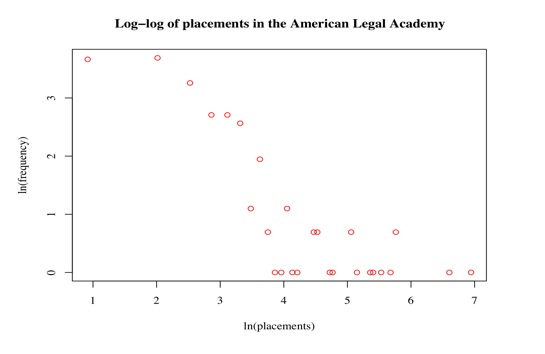
This extreme skewing of social authority presented in the visualization is also displayed in the above log-log of the degree distribution. While the -1.93 alpha level and size of the network falls outside the traditional power law/scale free range, the plot above does demonstrate the extreme skewing of social authority among institutions of legal education.
This is the time of year when there is significant discussion of the US News Rankings. We believe there is a wide-class of available data—data which could be characterized as the revealed preferences of important actors within the American legal system. For example, we have previous offered information on how judges select clerks from law schools? Now, we offer some empirical insight into how hiring committees vote over various institutions?
Coming later in the week, we will offer a Netlogo GUI which allows a user to start ideas at various institutions and observe how many generations they take to spread from institution to institution. There are significant caveats in the interpretation of our model but we think many people will still find it interesting. Please stay tuned and as always please tell your friends and colleagues about the CLS Blog!


